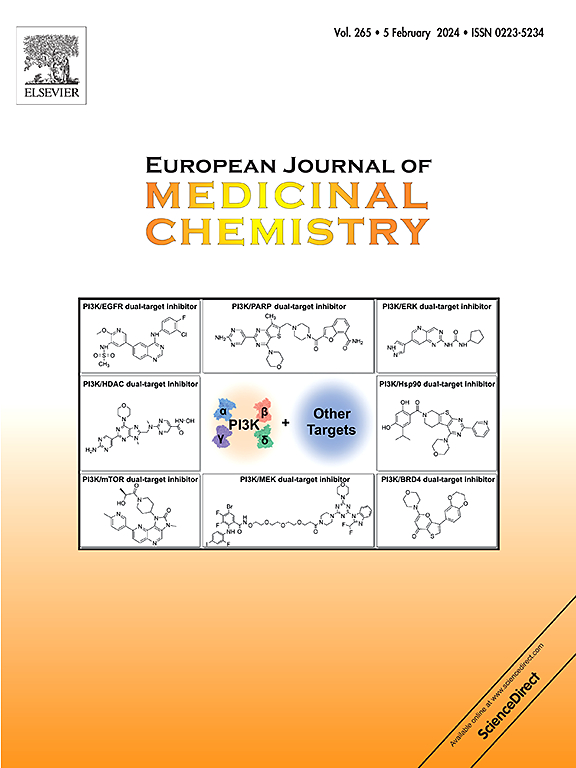Reducing burst release and enhancing sustained release in SAIB-based implants: The role of polyphenol-modification
IF 6
2区 医学
Q1 CHEMISTRY, MEDICINAL
引用次数: 0
Abstract
Sucrose acetate isobutyrate (SAIB)-based in situ forming implants (SADS) are promising for long-acting drug delivery but suffer from undesirable burst release. Here, we propose a molecular-level strategy to mitigate burst release by covalently modifying the antipsychotic drug aripiprazole (ARP) with polyphenols—specifically 4-hydroxybenzoic acid (HBA), protocatechuic acid (PCA), and gallic acid (GA). These moieties form strong hydrogen bonds with SAIB, enhancing drug–matrix interactions. Among them, ARP-GA exhibited the best performance, showing a significant reduction in burst release (8.99 ± 2.10 %) compared to unmodified ARP (22.84 ± 1.03 %) and sustained release over 30 days in vitro. In vivo pharmacokinetics in rats confirmed prolonged circulation with a 2.5-fold increase in AUC (1466.59 ± 139.35 vs. 592.66 ± 157.68 ng/mL•d), extended Tmax (6.40 ± 2.97 vs. 0.29 ± 0.42 days), and lower Cmax/CS (2.32 vs. 3.41), indicating improved release control. Rheological and porosity analysis supported the enhanced drug retention mechanism via hydrogen bonding. This approach also proved effective for six additional drugs, suggesting broad applicability. These findings demonstrate that polyphenol modification of APIs offers a carrier-compatible, drug-centric solution for burst release regulation. Overall, this strategy significantly enhances the safety and efficacy of SAIB-based long-acting injectable systems.


在saib基植入物中减少突发释放和增强持续释放:多酚修饰的作用
基于醋酸异丁酸蔗糖(SAIB)的原位成形植入物(SADS)是一种很有前景的长效药物递送材料,但存在不良的爆裂释放。在这里,我们提出了一种分子水平的策略,通过用多酚-特别是4-羟基苯甲酸(HBA)、原儿茶酸(PCA)和没食子酸(GA)共价修饰抗精神病药物阿立哌唑(ARP)来减轻突发释放。这些部分与SAIB形成强氢键,增强药物-基质相互作用。其中,ARP- ga表现最好,与未修饰的ARP(22.84±1.03%)相比,其爆发释放量(8.99±2.10%)显著降低,体外缓释期为30 d。大鼠体内药代动力学证实循环延长,AUC增加2.5倍(1466.59±139.35 vs 592.66±157.68 ng/mL•d), Tmax延长(6.40±2.97 vs 0.29±0.42天),Cmax/CS降低(2.32 vs 3.41),表明释放控制得到改善。流变学和孔隙学分析支持通过氢键增强药物保留机制。这种方法也被证明对另外六种药物有效,表明了广泛的适用性。这些发现表明,多酚修饰原料药提供了一种载体兼容的、以药物为中心的突发释放调节解决方案。总的来说,这一策略显著提高了基于saib的长效注射系统的安全性和有效性。
本文章由计算机程序翻译,如有差异,请以英文原文为准。
求助全文
约1分钟内获得全文
求助全文
来源期刊
CiteScore
11.70
自引率
9.00%
发文量
863
审稿时长
29 days
期刊介绍:
The European Journal of Medicinal Chemistry is a global journal that publishes studies on all aspects of medicinal chemistry. It provides a medium for publication of original papers and also welcomes critical review papers.
A typical paper would report on the organic synthesis, characterization and pharmacological evaluation of compounds. Other topics of interest are drug design, QSAR, molecular modeling, drug-receptor interactions, molecular aspects of drug metabolism, prodrug synthesis and drug targeting. The journal expects manuscripts to present the rational for a study, provide insight into the design of compounds or understanding of mechanism, or clarify the targets.

 求助内容:
求助内容: 应助结果提醒方式:
应助结果提醒方式:


